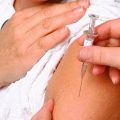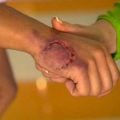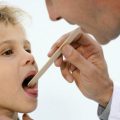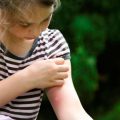Tetanus is a person - an acute and life-threatening disease, having a very broad range of different displays. Emergency treatment and preventive measures can save lives, if diagnosed in time. Because it is important to know the symptoms of tetanus, and how the disease manifests itself in different stages of infection.
How are infected with tetanus
Tetanus relates to diseases zooantroponoznym, that is, a disease characterized by both animals, and man. Infection may be in the soil, in the feces of animals and birds, in particles of dust for quite a long time. tetanus virus is highly resistant to survive in different environments - carry disinfection, high and low temperature.
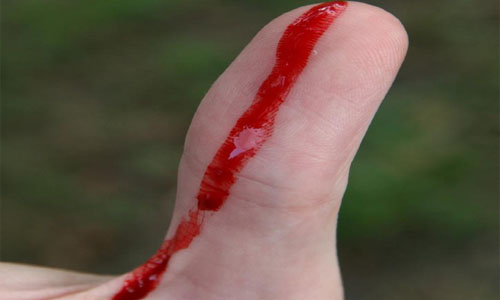
In humans the infection enters exclusively contact method, penetrating wounds (scratch, burns, cracks) on the skin of any origin.
The main ways of infection:
- Burn and operating wounds;
- dental injuries;
- Wounds from frostbite;
- puncture, gunshot wounds;
- ulcers, cracks, Damage to the foot, footsteps;
- open fractures, injury from shattered bones;
- Entering through the umbilical wound infection in newborns;
- Wounds after a dog bite (cat bite).
At risk of tetanus infection are farmers and cattle breeders - people, having frequent contact with soil, children under the age of 10 years old (due to the high level of injury), newborns in violation of the rules of antiseptics in childbirth.
Tetanus is called the "disease of bare feet", tk. more than half of infections occur through the damaged foot (ing in, scratch, crack) with soil.
The main symptoms
The incubation period from the time of infection until the first symptoms can be from one to 15 days. The duration of the incubation period, and the speed of development of the disease depends on the depth of the wound, space injured, through which infection occurred, the amount of virus.

Important! The main symptom of tetanus - twitching of facial muscles. These manifestations occur in different periods of time, making it difficult to diagnose the disease.
The main symptoms:
- Contraction of the muscles on the face (the emergence of "sardonic" smile);
- swallowing difficulties;
- The emergence of pain in the muscles;
- Shortness of breath;
- strong sweating;
- Increased tone in the muscles;
- salivation;
- Shortness of breath;
- Fever;
- Disturbances in defecation and urination.
Acute symptoms accompanied for tetanus, in which there is a spasm of the various muscle fibers.
Start infection is characterized by pain and "twitching" in the place of infection. After, the disease can be divided into several periods:
- incubatory (latent);
- Elementary;
- the midst of the disease;
- stage recovery.
Symptoms incubation period
During this period, the infection does not show pronounced symptoms, detect the disease only by means of analysis.

The duration of the latent stage depends on the severity of the manifestations - the shorter the incubation period, the less pronounced symptoms of tetanus.
Signs of early stage:
- The emergence of migraine;
- Lomota;
- Muscle tension in injury;
- The feeling of irritation and discomfort;
- increased perspiration.
The average duration of the period - 12 day, but can be up to three months. In this case, the disease most often begins suddenly to humans, especially in cases, when the place of infection have been identified.
Symptoms initial stage
This period lasts for 1-2 days and is characterized by the appearance of pain in the wound, through which infection occurred, even if it has become a place to heal.

There are specific signs:
- Contraction of the muscles above the place injured.
- Lockjaw - tonic spasm in the muscles of the temporo-mandibular region, restricting chewing function.
- Sardonic smile - facial muscles are reduced: mouth corners stretched, eye narrowed, wrinkled forehead (cm. a photo).
- Dysphagia - specific reduction of muscles of the pharynx, accompanied by pain.
Important! dysphagia, trismus and sardonic smile - specific symptoms, specific to tetanus.
There may be muscle spasms occipital, whereby it becomes difficult to bow his head to his chest.
Symptoms height period
This period is the peak of tetanus symptoms, the midst of the disease can last 1,5-2 week, depending on the severity of the.
typical manifestations:
- Twitching cover all body, as if coming down from the head to the feet. Seizures occur unexpectedly, their build-up takes place gradually, and time can be from several seconds to a minute. The intensity of the cramps are so strong, that person is literally "breaks" - turns the joints and bones, tendon tears.
- Muscular tonic tension reaches its peak and continues unabated even at night, accompanied by severe pain. There is a tetanus opisthotonus (on photo): belly hardens, the torso is bent arch, arms bent at the elbows, and his legs stretched out "toe the line".
- Breathing due to disturbances in the diaphragm becomes difficult, there are signs of asphyxia.
All these processes are accompanied by fever, excessive salivation, disturbances in defecation and urination.
Frequent seizures - for a day, they can occur dozens of times. In this case, the person's face becomes cyanotic hue, It expresses the pain and suffering, a person may increase temperature and blood pressure. The patient screams, moans, grinds his teeth, pants.
Muscle contraction is so strong, which can lead to a fracture of the vertebrae, tearing of muscles and ligaments.
Important! When the intensity of the symptoms of tetanus without treatment and timely assistance often comes death.
Symptoms of convalescence
recovery period occurs depending on the disease severity by the end of 2-3 of the week. The frequency of seizures gradually decreases, reduced muscle tone, general condition improves.
a full recovery process is very time-consuming and may take 2-3 of the month. In the absence of complications is possible to cure the disease.
Forms of tetanus and symptoms
the disease, Symptoms and treatment of tetanus depend on the form of the disease:
- mild form. The incubation period may be more than 20 days. It has been a slight rise in temperature, mild symptoms of tetanus (lockjaw, dysphagia, sardonic smile). Symptoms may not manifest itself, tk. there is a hidden and latent pathology for. If you do not carry out treatment, a transition in the acute phase of the disease.
- moderate form. Develops within 15-20 days, while clinical symptoms increase for 3-4 day. typical symptoms (dysphagia, lockjaw, sardonic smile) become pronounced, frequent seizures, temperature can reach 39 degrees. There is an increased heart rate, increased blood pressure, It appears excessive sweating.
- severe form. disease occurs during 7-14 days, symptoms increase during the day. Muscle tension pronounced, cramps occur several times per hour. Observed sharp pressure peaks, temperature increase, tachycardia.
- Very severe. Rapid form of tetanus, ending often fatal. The incubation period is only a few days, symptomatology is growing right before your eyes: fits virtually unabated, temperature exceeds the mark 40 degrees. Require resuscitation.
local form
There is also a local form of tetanus, in which symptomatology is expressed locally, and the characteristic signs of the disease are often unnoticeable.
The symptoms of tetanus in adults with topical formulation depend on the lesion:
- Local twitch in the area of infection without joining other specific manifestations of tetanus.
- muscle pain at the wound.
In this case, the infection does not get much deep, because the defeat does not hurt internal organs. Lethal outcome in this form of tetanus can arise only due to allergic complications.
neonatal tetanus
It is a rare form of the disease, which often ends in death of child. The disease is quite severe, newborn child has only acute forms of tetanus

In newborns, the disease manifests itself in violation of swallowing and sucking, the emergence of a sardonic smile, reduction of facial muscles. Seizures and convulsions in children with low birth weight may be manifested arching in one direction only.
complications of tetanus
The disease can be complicated by a variety of processes, in which tetanus treatment may take several months. The most dangerous complication is choking (asphyxia), in which there comes depression of cardiac activity and possible heart attack.
Other complications of tetanus:
- heart failure;
- Rupture of muscles and ligaments;
- Fractures of the spine and bones;
- Bronchitis and pneumonia;
- Sepsis;
- Pain shock.
In children, complications from tetanus manifests itself in the form of pneumonia, in the later stages of the disease - anemia, disorder of the digestive system.
Prediction tetanus depends on the shape of the flow and gravity process. On the severe stages of the disease with a rapidly developing clinical picture, death usually occurs as a result of delays aid.
Tetanus occurs quite hard, therefore it is better to prevent the occurrence of disease. To do this, conducted immunization, which involves both adults and children. After being vaccinated against tetanus risk of infection is minimized.






